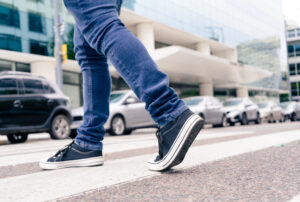Traffic laws often require drivers and pedestrians to prevent devastating pedestrian accidents. That is why both pedestrians and motorists must understand right-of-way rules, specifically, who has the right-of-way and how the regulations apply under specific circumstances.
In the below blog post, we hope to clear up some of the misunderstandings surrounding pedestrians and the right-of-way to help you understand your legal options if you experience a pedestrian accident. This post explains the remedies you can pursue and how an experienced pedestrian accident lawyer can help you fight for the financial recovery you deserve.
Pedestrians and Right-of-Way Regulations

According to state regulations, there are numerous scenarios with pedestrians and the right-of-way.
Take, for example:
Following Traffic Signals
Pedestrians need to obey traffic control devices that always apply to pedestrians. This requirement means that the pedestrian must stop when a traffic signal indicates for them to do so. However, if there is a police officer present that gives a different instruction, the pedestrian needs to follow the police officer’s command.
Using Sidewalks
Pedestrians must use sidewalks whenever they are available. When sidewalks are present, it is against the law for pedestrians to walk in the street unless an exception applies, such as when there is an emergency or construction present that forces pedestrians onto the road.
If there are no sidewalks, pedestrians may walk on the shoulder of the road. However, they need to walk against the traffic flow on the left side of the street.
Crosswalks
Motorists must stop for pedestrians in a crosswalk with a walk sign. In addition, if a pedestrian is lawfully in the crosswalk, a motorist cannot get so close to the pedestrian that they put them in danger or interfere with them as they are crossing.
If the area has no control signals or traffic signs, the driver must still yield to pedestrians at crosswalks. However, if there is a tunnel or overhead crossing, the pedestrians must use these walkways rather than obstruct traffic.
Additionally, although pedestrians have the right-of-way in a crosswalk, they must wait until the coast is clear before entering the path of travel. And when there is traffic already in the crosswalk, the pedestrians need to yield the right-of-way to that vehicle.
Contact Us Today
Running Into Traffic and Overtaking Another Vehicle
Pedestrians cannot run into traffic, and they may not leave the curb or other places away from traffic to run into a travel lane. A motorist also needs to leave enough space to travel when yielding to a pedestrian. It is illegal for a motor vehicle to overtake another vehicle stopped for pedestrians in a crosswalk.
Due Care and Caution Towards Pedestrians
Ultimately, a motorist is often better positioned to avoid an accident. Consequently, state laws often place some general responsibility on a motorist to stop, notice their surroundings, and use due care and caution to avoid colliding with pedestrians. The law also requires special consideration when incapacitated pedestrians or children are present.
Common Causes of Pedestrian Accidents
Although pedestrian accidents can occur for several different reasons, they often result from:
- Motorists driving under the influence of drugs or alcohol
- Distracted motorists
- Speeding
- Impatient drivers, including those who try to go around a pedestrian walking in a crosswalk
- Road construction areas that often force pedestrians to walk in places where drivers may not expect them
- Multi-lane roads
- Inclement weather
- Hazardous intersections
This list does not include every scenario that can give rise to a pedestrian accident. As a result, if another person’s reckless, intentional, or negligent actions harmed you in an accident, under any circumstances, reach out to an experienced pedestrian accident lawyer as soon as possible. These lawyers can go over what happened, figure out what caused the accident, and help you pursue the compensation you deserve.
Common Pedestrian Accident Injuries
Sadly, pedestrian accidents often produce catastrophic injuries.
The more common injuries that result from these accidents include:
- Broken bones
- Soft tissue injuries
- Traumatic brain injuries
- Spinal cord damage
- Facial injuries, including eye trauma
- Neck and back injuries
- Limb loss
- Musculoskeletal injuries
- Chest injuries
- Abdominal injuries
- Legs and pelvis trauma
- Tibial plateau fracture
- Wrongful death
Time Limitations and Pedestrian Accident Claims
Time is not on your side when it comes to an injury claim following a pedestrian accident. According to the statute of limitations, a law that mandates how much time you have to file a legal suit following an alleged offense, those injured in a pedestrian accident in Florida have four years to file a lawsuit after the incident. However, if exceptions apply to this law, the deadline may change.
If a pedestrian accident injured you, reach out to a pedestrian accident lawyer as soon as possible. A lawyer can help you figure out the amount of time you have to file your suit, and they can correctly prepare and file your legal documents with the appropriate court before time runs out.
Types of Financial Damages You Can Pursue Following a Pedestrian Accident
If you suffered significant injuries in a pedestrian accident because of another person’s wrongful actions, you may be entitled to compensation, including economic and non-economic damages.
Economic Damages
These damages refer to the actual, verifiable losses that result from an accident, including:
- Past and current medical bills related to hospital stays, doctor visits, emergency medical services such as ambulance rides, surgeries, and prescription medications
- Future ongoing medical treatment costs
- Lost wages and reduced earning capacity
- Rehabilitative therapy costs, such as physical and occupational therapy
- Domestic replacement services
- Personal property damages
Non-economic Damages
These damages refer to the subjective losses that result from an accident. Because these losses are typically not easy to quantify, they are also often challenging to prove.
They include:
- Pain
- Suffering
- Emotional anguish
- Loss of enjoyment and quality of life
- Loss of companionship
- Loss of consortium
- Reputation loss
- Disfigurement
- Inconvenience
- Humiliation
Punitive Damages
Depending on the facts, a court may also award punitive damages. Unlike the above damages, punitive damages do not compensate a victim for the harm and losses they suffered following an accident. Rather, they penalize or punish the wrongdoer for their egregious actions and deter others from committing this same act in the future.
For a victim to win punitive damages following a pedestrian accident, the victim must show that the wrongful party was personally guilty of gross negligence or intentional misconduct through clear and convincing evidence.
Protect Your Legal Rights Following a Pedestrian Accident
As you recover after a pedestrian accident, the last thing you want to do is worry about getting people’s contact information or gathering evidence from the scene. However, to ensure your legal rights remain protected following such an accident, consider doing the following:
#1. Call 911 Immediately
After a pedestrian accident, you or someone around you should call 911 immediately. This action is the quickest way to alert medical personnel and the police of the accident and your injuries and get the accident on record. Plus, once the police arrive, they can investigate the incident and write down their findings in their police report. If you decide to pursue legal action, this report can provide you and your attorney with valuable evidence.
#2. Collect Evidence from the Scene
If possible, collect as much evidence from the accident scene as possible. Include photos and videos of your visible injuries, the vehicles involved in the crash, skid marks on the street, road defects, weather conditions, traffic signs or signals near the area, and any other evidence that can help show what happened.
If you cannot collect this evidence because of your injuries, do not worry. Once you hire an experienced pedestrian accident attorney to take on your claim, they can obtain this evidence on your behalf.
#3. Obtain Driver and Witness Details
If possible, obtain the names of all those involved in the accident, including their contact information, driver’s license numbers, and insurance information.
In addition, if there were people present at the scene who saw what happened, try to get their names and information. These individuals can often provide your lawyer with further details about the accident and testify to validate your claim.
As you talk to these other individuals, watch what you say, primarily since they can use your comments against you. Avoid making definitive statements about the incident, apologizing for what happened, or taking the blame for anything that occurred.
#4. See a Doctor
Even if an emergency vehicle does not immediately transfer you to the hospital following your accident, you should still see a doctor as soon as possible. Sometimes, serious injuries such as brain trauma or spinal cord damage can take time to manifest. The longer you wait to get these conditions checked out, the more debilitating and deadly they can become.
In addition, when a doctor checks you over, they can provide you with a medical report that will detail information about your injuries and serve as evidence of a direct link between the harm you sustained and your pedestrian accident. You may need this evidence if the other side’s insurance company argues that your injuries are not serious or result from a subsequent event.
Work With an Experienced Pedestrian Accident Lawyer and Pursue the Damages You Deserve
Although the rules are relatively straightforward for pedestrians and the right-of-way, not every driver abides by them. Consequently, thousands of pedestrians are severely injured or killed by motor vehicles every year.
 If you or your loved one sustained severe injuries in a pedestrian accident, you do not have to deal with the debilitating consequences alone.
If you or your loved one sustained severe injuries in a pedestrian accident, you do not have to deal with the debilitating consequences alone.
Rather, when you hire an experienced pedestrian accident lawyer to take on your case, they can:
- Evaluate your claim, determine if you have a viable case, and figure out your legal options.
- Investigate your case thoroughly and secure needed evidence to show fault and damages.
- Ensure that the at-fault parties are held accountable for your sustained harm and losses.
- Handle all the negotiations with the other side and the insurer, and go after a just settlement offer.
- Take your case to trial and fight for maximum damages if the other side is unwilling to provide you with a fair settlement.
If a pedestrian accident disrupted your life or the life of a loved one, do not wait to get the legal help you need. Contact an experienced pedestrian accident lawyer today for your free case consultation and see how they can help you fight for your rights and the justice you deserve.


 (727) 669-2828
(727) 669-2828

 If you or your loved one sustained severe injuries in a pedestrian accident, you do not have to deal with the debilitating consequences alone.
If you or your loved one sustained severe injuries in a pedestrian accident, you do not have to deal with the debilitating consequences alone.